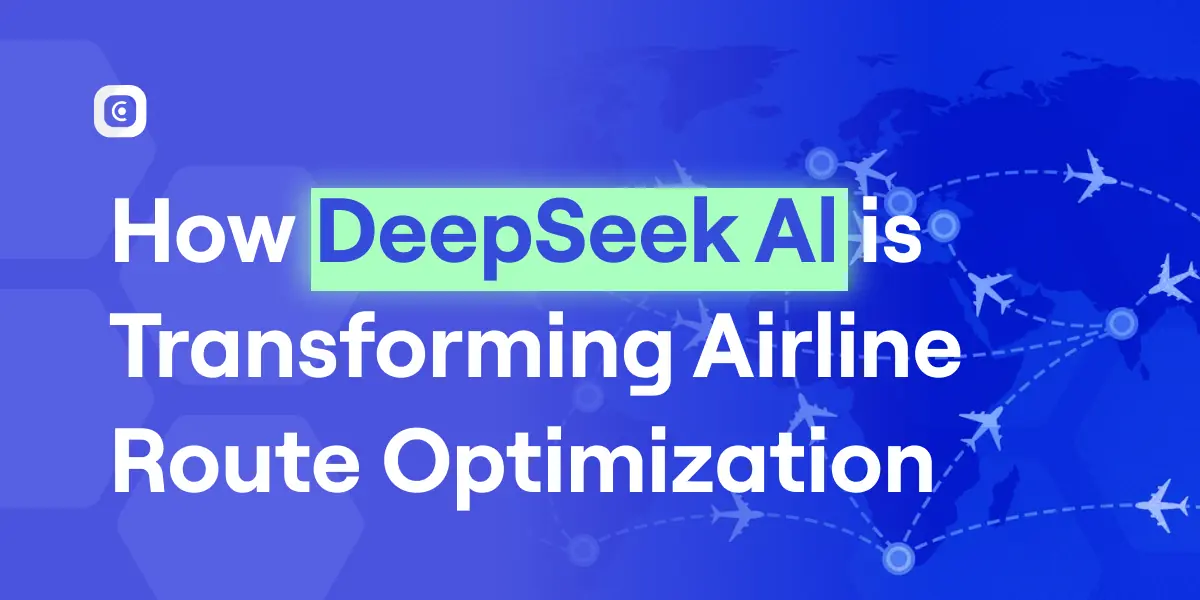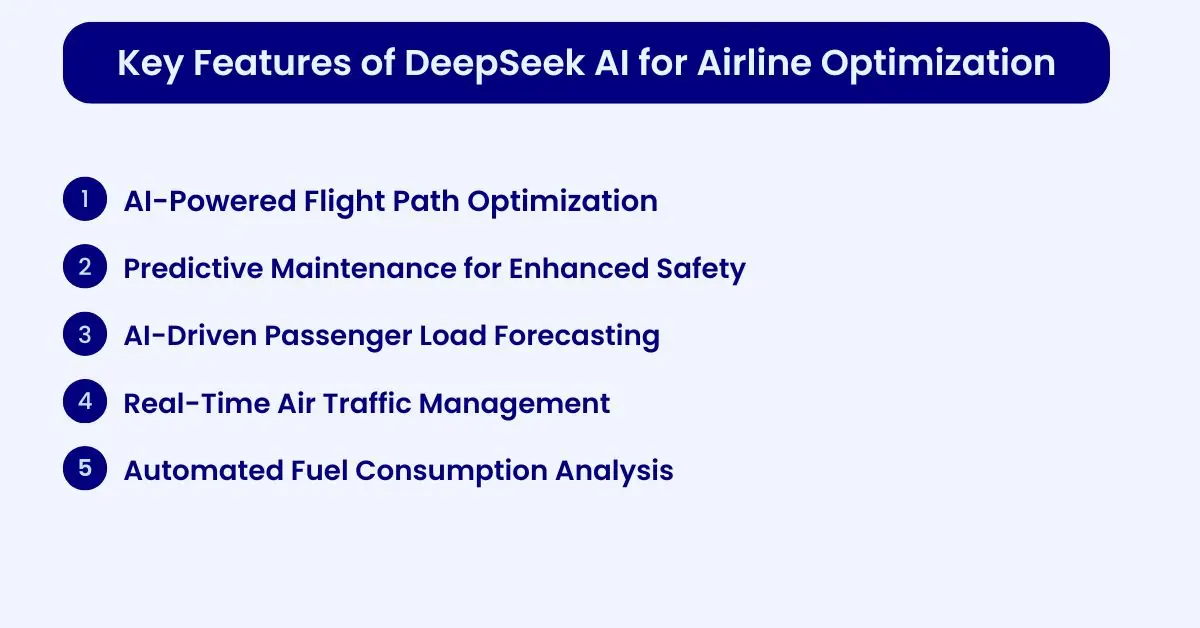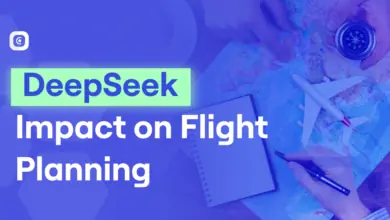How DeepSeek Al is Transforming Airline Route Optimization?

The travel industry is adopting artificial intelligence on a much larger scale than ever. This is mainly because AI has let OTAs, TMCs, and DMCs, deliver exceptional customer service with minimal hassle. However, many are still not aware of the fact that the capabilities of AI do not only favor customers but airlines as well.
Airlines have to put up with many challenges like rising fuel costs, airspace congestion, unpredictable weather conditions, and much more. These issues can be efficiently addressed by smart and efficient AI models that empower airlines to operate with sustainable resources by suggesting the most optimal routes.
This blog will discuss how a popular open-source AI model named DeepSeek can help with transforming airline route optimization. We’ll dive into how DeepSeek can help airlines by, slashing costs, reducing carbon footprints, and creating smoother. So without any further ado, let’s begin.
The Role of AI in Airline Route Optimization
Before getting started with anything too technical, let’s break down how DeepSeek can be the game-changer in aviation. The advanced machine learning and real-time deep analytics data capabilities of DeepSeek allow airlines to plan and execute flight routes with maximum efficiency. This intelligent system boasts multiple benefits for airline route optimization like:
- Analyze weather forecasts
- Study fuel consumption patterns
- Monitor air traffic conditions
- Dynamically optimize routes
- Reduce fuel usage
- Cut operational costs
- Enhance on-time performance
The DeepSeek AI model can be optimized to study and rectify all the challenges faced by the airline industry and revamp the future of AI-driven aviation.
Why Airlines Are Turning to AI for Route Planning
To stay relevant in the competition with industry leaders, adopting AI-driven solutions is no longer an option, it’s a necessity. Ever since the concept of flight booking APIs has become prevalent, businesses are actively looking for ways to improve their services. This remains true for airlines as well.
Traditional route planning methods, often based on historical data and static models, fail to account for real-time variables. This is where DeepSeek AI comes into the picture. This artificial intelligence extension can not only help improve overall customer experience but also adjust flight paths dynamically using live data.
All these factors will help airlines to reduce overall fuel costs and enhance operational efficiency. Once proven effective, there is a huge possibility that customers may be able to book their journeys at a lower cost.

How AI is Enhancing Airline Route Optimization?
Let’s quickly go through the different ways AI can help optimize and enhance airline routes.
Machine Learning for Dynamic Route Adjustments
Adjusting airline routes is not an easy task as it has multiple factors at play. This decision requires a vast amount of data in real-time alongside, the airport arrival, required fuel, and weather conditions. DeepSeek’s advanced AI architecture carefully analyzes all the patterns to provide a dynamic route for airlines to cover longer distances at a lower cost.
AI-Driven Fuel Efficiency Optimization
Manually discovering the most fuel-efficient path for airlines is practically impossible. This practice requires an advanced system that considers various parameters like altitude adjustments, wind speeds, and airspace congestion before suggesting a route. This is exactly what DeepSeek is capable of doing to minimize fuel burn and carbon emissions.
Real-Time Traffic & Weather Analysis
Airline traffic control is a very crucial aspect when it comes to passenger safety. Normally these tasks are taken care of manually via radar systems to monitor aircraft positions in the sky. However, DeepSeek AI can enable professionals to adjust flight paths in case of emergencies like flight delays and extreme weather conditions.
Cost Reduction Through Predictive Analytics
The cost associated with every flight ticket is a result of how much the airline has to pay for managing the flights. Now imagine how lower the prices can go for travelers if these costs were reduced by AI-driven solutions like optimized scheduling, reduced idle time, and forecasting maintenance requirements.
What Makes DeepSeek AI Different from Traditional AI Systems?
Despite being equipped with advanced deep learning models, traditional AI solutions like ChatGPT or Meta fall short in analyzing data in real-time. This is where DeepSeek has got an edge, as processes large-scale aviation data with maximum accuracy without any delays.
What’s more, its ability to integrate with global aviation databases ensures faster decision-making. As a result, many operational inefficiencies get canceled out resulting in the best results for efficient decision-making for airlines.
Key Features of DeepSeek AI for Airline Optimization

Now, let’s go through all the crucial features offered by DeepSeek for optimizing airline routes without any manual intervention.
AI-Powered Flight Path Optimization
The most efficient method utilized by DeepSeek AI to optimize flight paths is by keeping repair needs, unexpected breakdowns, and timely interventions in check. Basically, this allows the airline to set up a route in real-time with all possible conditions to cut down fuel costs and the time required to travel from one airport to another.
Predictive Maintenance for Enhanced Safety
To keep important factors like safety into consideration, DeepSeek AI can predict potential failures by analyzing the performance of aircraft every time it completes a journey. This saves a lot of time and also reduces the risk of unexpected breakdowns and costly repairs.
AI-Driven Passenger Load Forecasting
Flight booking engines are already equipped with features like predictive analysis and customer behavior during peak seasons. So why not use it to forecast passenger load in aircraft as well? Simply put, DeepSeek can analyze forthcoming trends and suggest possible solutions like increasing the flight frequencies to adjust accordingly.
Real-Time Air Traffic Management
Busy airports often struggle to manage flights constantly when there are unpredictable delays or emergencies like extreme weather conditions. These problems can be rectified with DeepSeek as it can provide better coordination between airlines and ground control, reducing congestion in busy airspaces.
Automated Fuel Consumption Analysis
And lastly, DeepSeek can also help the control stations monitor fuel usage in real-time. This helps in identifying inefficiencies and suggesting corrective measures to airlines if there are some issues with the aircraft. This is simply an extension to improve passenger safety and ensure that the aircraft can make the journey without any hassle.

Real-World Implementations of AI in Airline Route Optimization
While DeepSeek is relatively new to the market, AI has already proven its worth in multiple scenarios by increasing airline efficiency and security. Here are a few real-world scenarios:
How Airlines Are Leveraging AI for Efficiency
Many airlines use artificial intelligence, particularly to identify improved routes, throughout their operations. Fuel consumption has been reduced by up to 5%, according to prominent industry leaders. This improvement means costs are much lower and the carbon footprint is much smaller.
Airlines also benefit from improved on-time performance, given that AI scheduling and path alterations render flight routes quite efficient. These advanced technologies, as they are thoroughly put into practice, reshape aviation greatly, making travel experiences far better for passengers in addition to improving operations.
AI-Powered Air Traffic Management & Control
Artificial intelligence is changing air traffic handling by analyzing and predicting all traffic jams, thereby assigning flight slots in a far more efficient and dynamic way. AI uses advanced algorithms and current data to coordinate many aircraft, which greatly lessens delays.
This novel innovation greatly improves the running efficiency of airports. It also greatly improves overall operations, creating smoother journeys from takeoff to landing. Although its usage has not been normalized given the trend, it will soon be utilized by every airport.
Challenges & Ethical Considerations in AI-Based Route Optimization
While there are some definite advantages of using DeepSeek for airline route optimization, let’s also go through the possible challenges this technology poses to the flight booking industry.
Ethical Concerns & AI Decision-Making in Aviation
It may take a while for people to get used to trusting AI as their advisor and decision-maker. Regardless of its capabilities, human oversight remains essential to ensure accountability in decision-making. However, if the system is optimized to provide transparent and efficient results, more people will agree to adapt to this revolution.
Integration with Legacy Systems & Adoption Barriers
AI integration can be a tad bit challenging for some airlines as they operate on an outdated infrastructure. However, if continues it’ll be harder for such players to exist in this evolving competition. As a result, sooner we can find many traditional airlines adopting modern AI-compatible systems for better service and communication.
Ensuring Data Accuracy & Security in AI Models
AI’s effectiveness depends on high-quality data. Airlines must implement robust data security protocols to safeguard sensitive information from cyber threats. As a result, it’s important for businesses to ensure that their supplier is providing solutions that follow all industry regulations like CCPA, GDPR, and PCI-DSS.
Flying into the Future: AI-Optimized Routes with DeepSeek
There is no denying DeepSeek is now the first thing that comes to mind for most when considering the revolution in airline route optimization. DeepSeek AI’s AI-driven solutions are powerfully shaping aviation’s future by greatly improving efficiency. These solutions are also substantially reducing costs in addition to absolutely guaranteeing sustainability. OneClick can assist many airlines in using AI to remain competitive, along with providing every traveler with an easy trip.
DeepSeek AI employs both deep learning and real-time data processing to modify flight routes, decrease fuel use and raise efficiency to a greater degree than ordinary systems.
AI improves decision-making extensively, but it replaces no human oversight. Data-driven recommendations are provided with human experts, thereby guaranteeing safety in addition to functional compliance.
AI assesses weather, air traffic and airplane performance to propose optimal, fuel-saving routes, which reduces expenses and overall carbon emissions.
Integrating with current systems that are already in place, making sure data is accurate enough, handling many cybersecurity problems and keeping up with all rules are major problems in decision-making that is directed by AI.
To be certain that special AI tools work well with current flight plans, airlines can form alliances with AI tech companies such as OneClick to add those tools.



